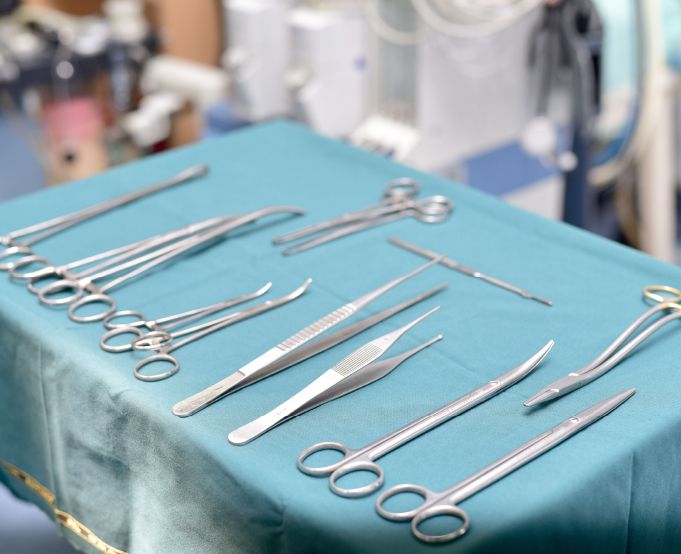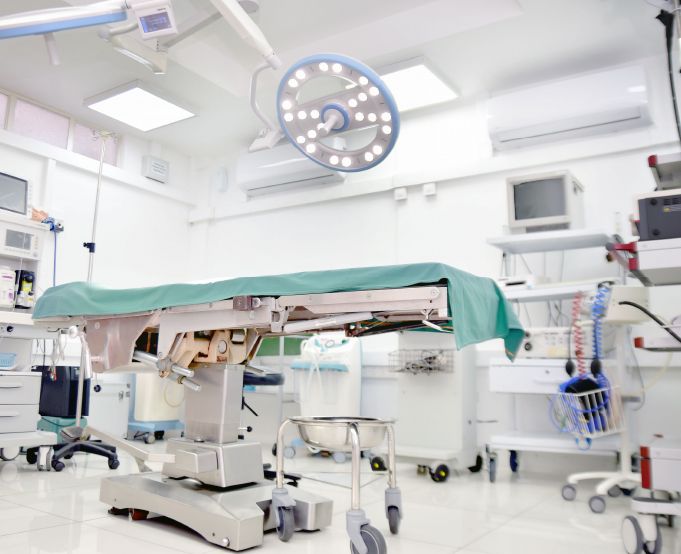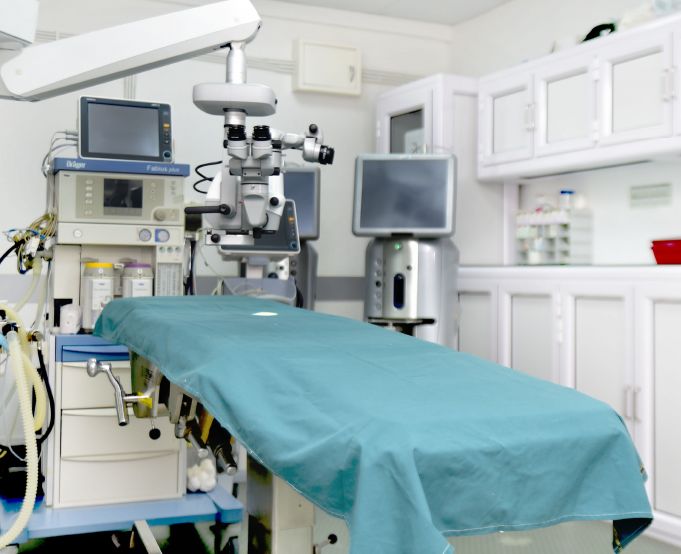Emergency Tel: 211 5157
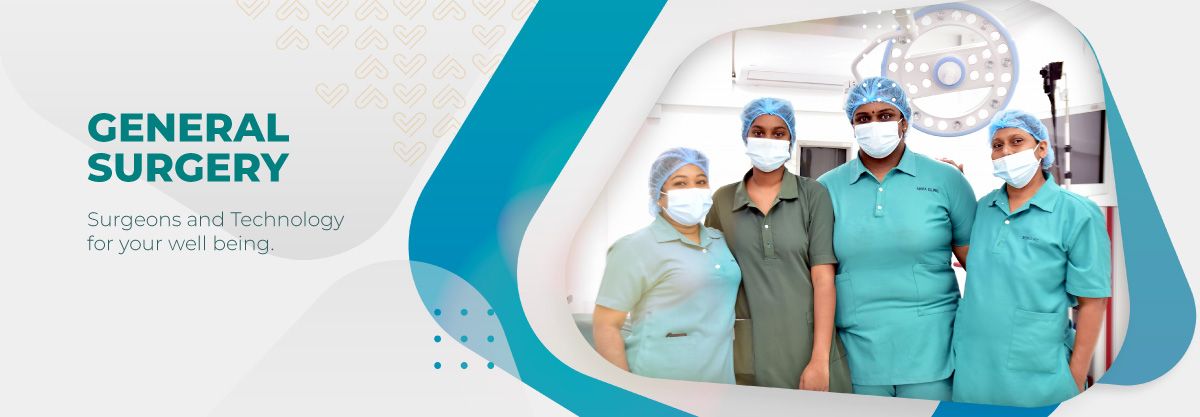
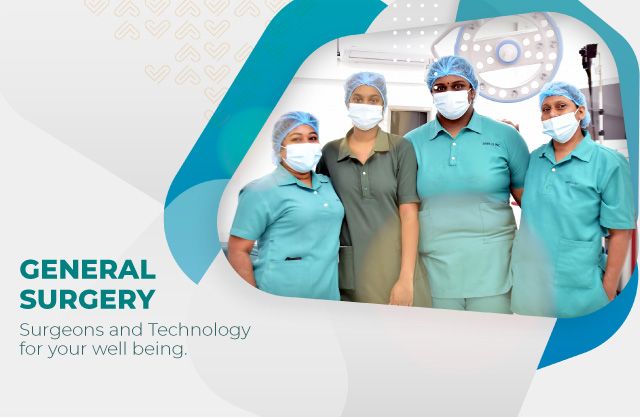
- Home
- Specialities
- General Surgery
General Surgery
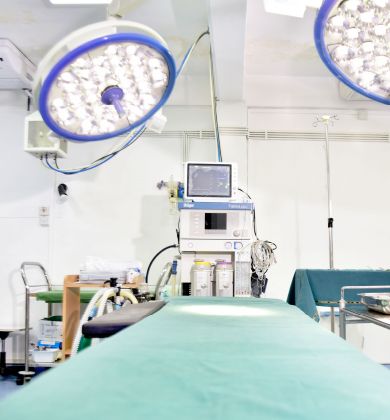
-
Appendicitis and Appendectomy
Symptoms
Signs and symptoms of appendicitis may include:- Sudden pain that begins on the right side of the lower abdomen
- Sudden pain that begins around your navel and often shifts to your lower right abdomen
- Pain that worsens if you cough, walk or make other jarring movements
- Nausea and vomiting
- Loss of appetite
- Low-grade fever that may worsen as the illness progresses
- Constipation or diarrhea
- Abdominal bloating
- Flatulence
The site of your pain may vary, depending on your age and the position of your appendix. When you're pregnant, the pain may seem to come from your upper abdomen because your appendix is higher during pregnancy.
Surgery to remove the appendix (appendectomy)
Appendectomy can be performed as open surgery using one abdominal incision about 2 to 4 inches (5 to 10 centimeters) long (laparotomy). Or the surgery can be done through a few small abdominal incisions (laparoscopic surgery). During a laparoscopic appendectomy, the surgeon inserts special surgical tools and a video camera into your abdomen to remove your appendix. -
Colectomy
Colectomy is a surgical procedure to remove all or part of your colon. Your colon, part of your large intestine, is a long tubelike organ at the end of your digestive tract. Colectomy may be necessary to treat or prevent diseases and conditions that affect your colon.
There are various types of colectomy operations:- Total colectomy involves removing the entire colon.
- Partial colectomy involves removing part of the colon and may also be called subtotal colectomy.
- Hemicolectomy involves removing the right or left portion of the colon.
- Proctocolectomy involves removing both the colon and rectum.
Colectomy surgery usually requires other procedures to reattach the remaining portions of your digestive system and permit waste to leave your body.
Why it's done
Colectomy is used to treat and prevent diseases and conditions that affect the colon, such as:- Bleeding that can't be controlled. Severe bleeding from the colon may require surgery to remove the affected portion of the colon.
- Bowel obstruction. A blocked colon is an emergency that may require total or partial colectomy, depending on the situation.
- Colon cancer. Early-stage cancers may require only a small section of the colon to be removed during colectomy. Cancers at a later stage may require more of the colon to be removed.
- Crohn's disease. If medications aren't helping you, removing the affected part of your colon may offer temporary relief from signs and symptoms. Colectomy may also be an option if precancerous changes are found during a test to examine the colon (colonoscopy).
- Ulcerative colitis. Your doctor may recommend total colectomy or proctocolectomy if medications aren't helping to control your signs and symptoms. Proctocolectomy may also be recommended if precancerous changes are found during a colonoscopy.
- Diverticulitis. Your doctor may recommend surgery to remove the affected portion of the colon if your diverticulitis recurs or if you experience complications of diverticulitis.
- Preventive surgery. If you have a very high risk of colon cancer due to the formation of multiple precancerous colon polyps, you may choose to undergo total colectomy to prevent cancer in the future.
After your colectomy
- After surgery you'll be taken to a recovery room to be monitored as the anesthesia wears off. Then your health care team will take you to your hospital room to continue your recovery.
- You'll stay in the hospital until you regain bowel function. This may take a couple of days to a week.
- You may not be able to eat solid foods at first. You might receive liquid nutrition through a vein, often in your arm, and then transition to drinking clear liquids. As your intestines recover, you can eventually add solid foods.
If your surgery involved a colostomy or ileostomy to attach your intestine to the outside of your abdomen, you'll meet with an ostomy nurse who will show you how to care for your stoma. The nurse will explain how to change the ostomy bag that will collect waste.
-
Mastectomy
A mastectomy is surgery to remove all breast tissue from a breast as a way to treat or prevent breast cancer.
For those with early-stage breast cancer, a mastectomy may be one treatment option. Breast-conserving surgery (lumpectomy), in which only the tumor is removed from the breast, may be another option.
Surgery to restore shape to your breast — called breast reconstruction — may be done at the same time as your mastectomy or during a second operation at a later date.
Why it's done
A mastectomy is used to remove all breast tissue if you have breast cancer or are at very high risk of developing it. You may have a mastectomy to remove one breast (unilateral mastectomy) or both breasts (bilateral mastectomy).
Mastectomy for breast cancer treatment
A mastectomy may be a treatment option for many types of breast cancer, including:- Ductal carcinoma in situ (DCIS), or noninvasive breast cancer
- Stages I and II (early-stage) breast cancer
- Stage III (locally advanced) breast cancer — after chemotherapy
- Inflammatory breast cancer — after chemotherapy
- Paget's disease of the breast
- Locally recurrent breast cancer
Your doctor may recommend a mastectomy instead of a lumpectomy plus radiation if:
- You have two or more tumors in separate areas of the breast.
- You have widespread or malignant-appearing calcium deposits (microcalcifications) throughout the breast that have been determined to be cancer after a breast biopsy.
You've previously had radiation treatment to the breast region and the breast cancer has recurred in the breast. - You're pregnant and radiation creates an unacceptable risk to your unborn child.
- You've had a lumpectomy, but cancer is still present at the edges (margin) of the operated area and there is concern about cancer extending to elsewhere in the breast.
- You carry a gene mutation that gives you a high risk of developing a second cancer in your breast.
You have a large tumor relative to the overall size of your breast. You may not have enough healthy tissue left after a lumpectomy to achieve an acceptable cosmetic result. - You have a connective tissue disease, such as scleroderma or lupus, and may not tolerate the side effects of radiation to the skin.
Mastectomy to prevent breast cancer
You might also consider a mastectomy if you don't have breast cancer, but have a very high risk of developing the disease.
A preventive (prophylactic) or risk-reducing mastectomy involves removing both of your breasts and significantly reduces your risk of developing breast cancer in the future.
A prophylactic mastectomy is reserved for those with a very high risk of breast cancer, which is determined by a strong family history of breast cancer or the presence of certain genetic mutations that increase the risk of breast cancer. -
Lumpectomy
Lumpectomy is surgery to remove cancer or other abnormal tissue from your breast.
During a lumpectomy procedure, the surgeon removes the cancer or other abnormal tissue and a small amount of the healthy tissue that surrounds it. This ensures that all of the abnormal tissue is removed.
Lumpectomy is also called breast-conserving surgery or wide local excision because only a portion of the breast is removed. In contrast, during a mastectomy, all of the breast tissue is removed.
Why it's done
The goal of lumpectomy is to remove cancer or other abnormal tissue while maintaining the appearance of your breast. Studies indicate that lumpectomy followed by radiation therapy is as effective in preventing a recurrence of breast cancer as removal of the entire breast (mastectomy) for early-stage breast cancer.
Your doctor may recommend lumpectomy if a biopsy has shown that you have cancer and that the cancer is believed to be small and early stage. Lumpectomy may also be used to remove certain noncancerous or precancerous breast abnormalities.
Your doctor may not recommend lumpectomy for breast cancer if you:- Have a history of scleroderma, a group of diseases that harden skin and other tissues and make healing after lumpectomy difficult
- Have a history of systemic lupus erythematosus, a chronic inflammatory disease that can worsen if you undergo radiation treatments
- Have two or more tumors in different quadrants of your breast that cannot be removed with a single incision, which could affect the appearance of your breast
- Have previously had radiation treatment to the breast region, which would make further radiation treatments too risky
- Have cancer that has spread throughout your breast and overlying skin, since lumpectomy would be unlikely to remove the cancer completely
- Have a large tumor and small breasts, which may cause a poor cosmetic result
- Don't have access to radiation therapy.
-
Laparoscopic cholecystectomy
Special surgical tools and a tiny video camera are inserted through incisions in your abdomen during laparoscopic cholecystectomy. Your abdomen is inflated with carbon dioxide gas to allow room for the surgeon to work with surgical tools.
Why it's done
A cholecystectomy is most commonly performed to treat gallstones and the complications they cause. Your doctor may recommend a cholecystectomy if you have:- Gallstones in the gallbladder (cholelithiasis)
- Gallstones in the bile duct (choledocholithiasis)
- Gallbladder inflammation (cholecystitis)
- Pancreas inflammation (pancreatitis) due to gallstones.
-
Cholecystitis
Cholecystitis is the inflammation of gall bladder.
Symptoms of cholecystitis may include:- Severe pain in your upper right or center abdomen
- Pain that spreads to your right shoulder or back
- Tenderness over your abdomen when it's touched
- Nausea
- Vomiting
- Fever
Cholecystitis symptoms often occur after a meal, particularly a large or fatty one.
When to see a doctor
Make an appointment with your health care provider if you have symptoms that worry you. If your abdominal pain is so severe that you can't sit still or get comfortable, have someone drive you to the emergency room. -
Breast Biopsy
A breast biopsy is a procedure to remove a sample of breast tissue for testing. The tissue sample is sent to a lab, where doctors who specialize in analyzing blood and body tissue (pathologists) examine the tissue sample and provide a diagnosis.
A breast biopsy might be recommended if you have a suspicious area in your breast, such as a breast lump or other signs and symptoms of breast cancer. It can also be used to investigate unusual findings on a mammogram, ultrasound or other breast exam.
The results of a breast biopsy can show whether the area in question is breast cancer or if it's not cancerous. The pathology report from the breast biopsy can help your doctor determine whether you need additional surgery or other treatment.
Why it's done
Your doctor may recommend a breast biopsy if:- You or your doctor feels a lump or thickening in the breast, and your doctor suspects breast cancer
- Your mammogram shows a suspicious area in your breast
- An ultrasound scan or breast magnetic resonance imaging (MRI) reveals a suspicious finding
- You have unusual nipple or areolar changes, including crusting, scaling, dimpling skin or a bloody discharge
-
Colonoscopy
During a colonoscopy, a long, flexible tube (colonoscope) is inserted into the rectum. A tiny video camera at the tip of the tube allows the doctor to view the inside of the entire colon.
Why it's done
Your doctor may recommend a colonoscopy to:- Investigate intestinal signs and symptoms. A colonoscopy can help your doctor explore possible causes of abdominal pain, rectal bleeding, chronic diarrhea and other intestinal problems.
- Screen for colon cancer. If you're age 45 or older and at average risk of colon cancer — you have no colon cancer risk factors other than age — your doctor may recommend a colonoscopy every 10 years. If you have other risk factors, your doctor may recommend a screen sooner. Colonoscopy is one of a few options for colon cancer screening. Talk with your doctor about the best options for you.
- Look for more polyps. If you have had polyps before, your doctor may recommend a follow-up colonoscopy to look for and remove any additional polyps. This is done to reduce your risk of colon cancer.
- Treat an issue. Sometimes, a colonoscopy may be done for treatment purposes, such as placing a stent or removing an object in your colon.
-
Circumcision
Circumcision is the surgical removal of the skin covering the tip of the penis. The procedure is fairly common for newborn boys in certain parts of the world, including the United States. Circumcision after the newborn period is possible, but it's a more complex procedure.
For some families, circumcision is a religious ritual. The procedure can also be a matter of family tradition, personal hygiene or preventive health care.
Circumcision might have various health benefits, including:- Easier hygiene. Circumcision makes it simpler to wash the penis. However, boys with uncircumcised penises can be taught to wash regularly beneath the foreskin.
- Decreased risk of urinary tract infections. The risk of urinary tract infections in males is low, but these infections are more common in uncircumcised males. Severe infections early in life can lead to kidney problems later.
- Decreased risk of sexually transmitted infections. Circumcised men might have a lower risk of certain sexually transmitted infections, including HIV. Still, safe sexual practices remain essential.
- Prevention of penile problems. Occasionally, the foreskin on an uncircumcised penis can be difficult or impossible to retract (phimosis). This can lead to inflammation of the foreskin or head of the penis.
- Decreased risk of penile cancer. Although cancer of the penis is rare, it's less common in circumcised men. In addition, cervical cancer is less common in the female sexual partners of circumcised men.
The risks of not being circumcised, however, are not only rare, but avoidable with proper care of the penis.
Circumcision might not be an option if certain blood-clotting disorders are present. Also, circumcision might not be appropriate for premature babies who still require medical care in the hospital nursery or for babies born with abnormalities of the penis.
Circumcision doesn't affect fertility, nor is circumcision generally thought to enhance or detract from sexual pleasure for men or their partners. -
Prostate biopsy
A prostate biopsy is a procedure to remove samples of suspicious tissue from the prostate. The prostate is a small, walnut-shaped gland in males that produces fluid that nourishes and transports sperm.
During a prostate biopsy a needle is used to collect a number of tissue samples from your prostate gland. The procedure is performed by a doctor who specializes in the urinary system and male sex organs (urologist).
Your urologist may recommend a prostate biopsy if results from initial tests, such as a prostate-specific antigen (PSA) blood test or digital rectal exam, suggest that you may have prostate cancer.
Why it's done
A prostate biopsy is used to detect prostate cancer.
Your doctor may recommend a prostate biopsy if:- A PSA test shows levels higher than normal for your age
- Your doctor finds lumps or other abnormalities during a digital rectal exam
- You've had a previous biopsy with a normal result, but you still have elevated PSA levels
- A previous biopsy revealed prostate tissue cells that were abnormal but not cancerous
-
Transurethral resection of the prostate (TURP)
It is a surgery used to treat urinary problems that are caused by an enlarged prostate.
An instrument called a resectoscope is inserted through the tip of your penis and into the tube that carries urine from your bladder (urethra). The resectoscope helps your doctor see and trim away excess prostate tissue that's blocking urine flow.
Why it's done
TURP helps reduce urinary symptoms caused by benign prostatic hyperplasia (BPH), including:- Frequent, urgent need to urinate
- Difficulty starting urination
- Slow (prolonged) urination
- Increased frequency of urination at night
- Stopping and starting again while urinating
- The feeling you can't completely empty your bladder
- Urinary tract infections
TURP might also be done to treat or prevent complications due to blocked urine flow, such as:
- Recurring urinary tract infections
- Kidney or bladder damage
- Inability to control urination or an inability to urinate at all
- Bladder stones
- Blood in your urine
Risks
Risks of TURP can include:
- Temporary difficulty urinating. You might have trouble urinating for a few days after the procedure. Until you can urinate on your own, you will need to have a tube (catheter) inserted into your penis to carry urine out of your bladder.
- Urinary tract infection. This type of infection is a possible complication after any prostate procedure. An infection is increasingly likely to occur the longer you have a catheter in place. Some men who have TURP have recurring urinary tract infections.
- Dry orgasm. A common and long-term effect of any type of prostate surgery is the release of semen during ejaculation into the bladder rather than out of the penis. Also known as retrograde ejaculation, dry orgasm isn't harmful and generally doesn't affect sexual pleasure. But it can interfere with your ability to father a child.
- Erectile dysfunction. The risk is very small, but erectile dysfunction can occur after prostate treatments.
- Heavy bleeding. Very rarely, men lose enough blood during TURP to require a blood transfusion. Men with larger prostates appear to be at higher risk of significant blood loss.
Difficulty holding urine. Rarely, loss of bladder control (incontinence) is a long-term complication of TURP. - Low sodium in the blood. Rarely, the body absorbs too much of the fluid used to wash the surgery area during TURP. This condition, known as TURP syndrome or transurethral resection (TUR) syndrome, can be life-threatening if untreated. A technique called bipolar TURP eliminates the risk of this condition.
- Need for re-treatment. Some men require follow-up treatment after TURP because symptoms don't improve or they return over time. Sometimes, re-treatment is needed because TURP causes narrowing (stricture) of the urethra or the bladder neck.
- Prostatectomy
Prostatectomy is surgery to remove part or all of the prostate gland. The prostate gland is situated in the male pelvis, below the urinary bladder. It surrounds the urethra, which carries urine from the bladder to the penis.
The procedure is used to treat a number of conditions affecting the prostate. It's most commonly used as a treatment for prostate cancer.
Why it's done
Most often, prostatectomy is done to treat localized prostate cancer. It may be used alone, or in conjunction with radiation, chemotherapy and hormone therapy.
Radical prostatectomy is surgery to remove the entire prostate gland and surrounding lymph nodes to treat men with localized prostate cancer.
Simple prostatectomy to treat BPH doesn't always involve removing the entire prostate, as in a radical prostatectomy. Instead, this procedure removes just the part of the prostate that's blocking the flow of urine. The surgery eases urinary symptoms and complications resulting from blocked urine flow, including:- A frequent, urgent need to urinate
- Difficulty starting urination
- Slow (prolonged) urination
- Increased urination frequency at night
- Stopping and starting again while urinating
- The feeling that you can't completely empty your bladder
- Urinary tract infections
- Inability to urinate
- Thyroidectomy
Thyroidectomy is the surgical removal of all or part of your thyroid gland. Your thyroid is a butterfly-shaped gland located in the front of your neck. It makes hormones that control every part of your metabolism, from your heart rate to how quickly you burn calories.
How much of your thyroid gland is removed during thyroidectomy depends on the reason for the surgery. If you need only part of your thyroid removed (partial thyroidectomy), your thyroid may work normally after surgery. If you need your entire thyroid removed (total thyroidectomy), you need daily treatment with thyroid hormone to replace your thyroid's natural function.
Why it's done
Your doctor may recommend thyroidectomy if you have conditions such as:- Thyroid cancer. Cancer is the most common reason for thyroidectomy. If you have thyroid cancer, removing most or all of your thyroid will likely be a treatment option.
- Noncancerous enlargement of the thyroid (goiter). Removing all or part of your thyroid gland may be an option for a large goiter. A large goiter may be uncomfortable or make it hard to breathe or swallow. A goiter may also be removed if it's causing your thyroid to be overactive.
- Overactive thyroid (hyperthyroidism). In hyperthyroidism, your thyroid gland produces too much of the hormone thyroxine. Thyroidectomy may be an option if you have problems with anti-thyroid drugs, or if you don't want radioactive iodine therapy. These are two other common treatments for hyperthyroidism.
- Suspicious thyroid nodules. Some thyroid nodules can't be identified as cancerous or noncancerous after testing a sample from a needle biopsy. If your nodules are at increased risk of being cancerous, you may be a candidate for thyroidectomy.
- Splenectomy
Splenectomy is a surgical procedure to remove your spleen. The spleen is an organ that sits under your rib cage on the upper left side of your abdomen. It helps fight infection and filters unneeded material, such as old or damaged blood cells, from your blood.
Why it's done
Splenectomy is used to treat a wide variety of diseases and conditions. Your doctor may recommend splenectomy if you have one of the following:- Ruptured spleen. If your spleen ruptures due to a severe abdominal injury or because of an enlarged spleen (splenomegaly), the result may be life-threatening, internal bleeding.
- Enlarged spleen. Splenectomy may be done to ease the symptoms of an enlarged spleen, which include pain and a feeling of fullness.
- Blood disorder. Blood disorders that may be treated with splenectomy include idiopathic thrombocytopenic purpura, polycythemia vera and thalassemia. But splenectomy is typically performed only after other treatments have failed to reduce the symptoms of these disorders.
- Cancer. Cancers that may be treated with splenectomy include chronic lymphocytic leukemia, Hodgkin's lymphoma, non-Hodgkin's lymphoma and hairy cell leukemia.
- Infection. A severe infection or the development of a large collection of pus surrounded by inflammation (abscess) in your spleen may require spleen removal if it doesn't respond to other treatment.
- Cyst or tumor. Noncancerous cysts or tumors inside the spleen may require splenectomy if they become large or are difficult to remove completely.
- Sclerotherapy
Sclerotherapy effectively treats varicose and spider veins. It's often considered the treatment of choice for small varicose veins.
Sclerotherapy involves injecting a solution directly into the vein. The sclerotherapy solution causes the vein to scar, forcing blood to reroute through healthier veins. The collapsed vein is reabsorbed into local tissue and eventually fades.
After sclerotherapy, treated veins tend to fade within a few weeks, although occasionally it may take a month or more to see the full results. In some instances, several sclerotherapy treatments may be needed.
Why it's done
Sclerotherapy is often done for:- Cosmetic purposes — to improve the appearance of varicose and spider veins
The procedure can also improve related symptoms such as:
- Aching
- Swelling
- Burning
- Night cramps
Doctor Schedule
Doctors scheduled for the week.
| Monday & Wednesday | 11hr - 13hr | Dr Nobeebux Youssu |
| Monday & Wednesday | 11hr - 13hr | Dr Nathire Hassed |
| Monday & Wednesday | 11hr - 13hr | Dr Joomun Ashraff |
| Monday & Wednesday | 11hr - 13hr | M. Dilshaad |
| Monday & Wednesday | 11hr - 13hr | Dr Dirouyarled Ramasawmy |
| Monday & Wednesday | 11hr - 13hr | Dr Bomah Anand |
| Monday & Wednesday | 11hr - 13hr | Dr Oasis Iqtidaar |
| Monday & Wednesday | 11hr - 13hr | Dr Hosany Nazir |
| Monday & Wednesday | 11hr - 13hr | Dr Ramdin Ian |
Doctors and Specialists of General Surgery
Contact Us
-

4, Labourdonnais Street,
Port-Louis -

(230) 211 5157
(230) 211 5181
(230) 211 7559 -

(230) 211 4647
Follow Chisty Shifa Clinic
Patients
Publications
Terms & Conditions | Privacy Policy | COPYRIGHT © 2022 Chisty Shifa.
All rights reserved. Powered by Nova Interaction

